Zijie Zhou
Industrial Internet Robot Collaboration System and Edge Computing Optimization
Apr 03, 2025Abstract:In a complex environment, for a mobile robot to safely and collision - free avoid all obstacles, it poses high requirements for its intelligence level. Given that the information such as the position and geometric characteristics of obstacles is random, the control parameters of the robot, such as velocity and angular velocity, are also prone to random deviations. To address this issue in the framework of the Industrial Internet Robot Collaboration System, this paper proposes a global path control scheme for mobile robots based on deep learning. First of all, the dynamic equation of the mobile robot is established. According to the linear velocity and angular velocity of the mobile robot, its motion behaviors are divided into obstacle - avoidance behavior, target - turning behavior, and target approaching behavior. Subsequently, the neural network method in deep learning is used to build a global path planning model for the robot. On this basis, a fuzzy controller is designed with the help of a fuzzy control algorithm to correct the deviations that occur during path planning, thereby achieving optimized control of the robot's global path. In addition, considering edge computing optimization, the proposed model can process local data at the edge device, reducing the communication burden between the robot and the central server, and improving the real time performance of path planning. The experimental results show that for the mobile robot controlled by the research method in this paper, the deviation distance of the path angle is within 5 cm, the deviation convergence can be completed within 10 ms, and the planned path is shorter. This indicates that the proposed scheme can effectively improve the global path planning ability of mobile robots in the industrial Internet environment and promote the collaborative operation of robots through edge computing optimization.
SegLocNet: Multimodal Localization Network for Autonomous Driving via Bird's-Eye-View Segmentation
Feb 28, 2025Abstract:Robust and accurate localization is critical for autonomous driving. Traditional GNSS-based localization methods suffer from signal occlusion and multipath effects in urban environments. Meanwhile, methods relying on high-definition (HD) maps are constrained by the high costs associated with the construction and maintenance of HD maps. Standard-definition (SD) maps-based methods, on the other hand, often exhibit unsatisfactory performance or poor generalization ability due to overfitting. To address these challenges, we propose SegLocNet, a multimodal GNSS-free localization network that achieves precise localization using bird's-eye-view (BEV) semantic segmentation. SegLocNet employs a BEV segmentation network to generate semantic maps from multiple sensor inputs, followed by an exhaustive matching process to estimate the vehicle's ego pose. This approach avoids the limitations of regression-based pose estimation and maintains high interpretability and generalization. By introducing a unified map representation, our method can be applied to both HD and SD maps without any modifications to the network architecture, thereby balancing localization accuracy and area coverage. Extensive experiments on the nuScenes and Argoverse datasets demonstrate that our method outperforms the current state-of-the-art methods, and that our method can accurately estimate the ego pose in urban environments without relying on GNSS, while maintaining strong generalization ability. Our code and pre-trained model will be released publicly.
Online Scheduling for LLM Inference with KV Cache Constraints
Feb 10, 2025Abstract:Large Language Model (LLM) inference, where a trained model generates text one word at a time in response to user prompts, is a computationally intensive process requiring efficient scheduling to optimize latency and resource utilization. A key challenge in LLM inference is the management of the Key-Value (KV) cache, which reduces redundant computations but introduces memory constraints. In this work, we model LLM inference with KV cache constraints theoretically and propose novel batching and scheduling algorithms that minimize inference latency while effectively managing the KV cache's memory. We analyze both semi-online and fully online scheduling models, and our results are threefold. First, we provide a polynomial-time algorithm that achieves exact optimality in terms of average latency in the semi-online prompt arrival model. Second, in the fully online case with a stochastic prompt arrival, we introduce an efficient online scheduling algorithm with constant regret. Third, we prove that no algorithm (deterministic or randomized) can achieve a constant competitive ratio in fully online adversarial settings. Our empirical evaluations on a public LLM inference dataset, using the Llama-70B model on A100 GPUs, show that our approach significantly outperforms benchmark algorithms used currently in practice, achieving lower latency while reducing energy consumption. Overall, our results offer a path toward more sustainable and cost-effective LLM deployment.
Tokenphormer: Structure-aware Multi-token Graph Transformer for Node Classification
Dec 19, 2024Abstract:Graph Neural Networks (GNNs) are widely used in graph data mining tasks. Traditional GNNs follow a message passing scheme that can effectively utilize local and structural information. However, the phenomena of over-smoothing and over-squashing limit the receptive field in message passing processes. Graph Transformers were introduced to address these issues, achieving a global receptive field but suffering from the noise of irrelevant nodes and loss of structural information. Therefore, drawing inspiration from fine-grained token-based representation learning in Natural Language Processing (NLP), we propose the Structure-aware Multi-token Graph Transformer (Tokenphormer), which generates multiple tokens to effectively capture local and structural information and explore global information at different levels of granularity. Specifically, we first introduce the walk-token generated by mixed walks consisting of four walk types to explore the graph and capture structure and contextual information flexibly. To ensure local and global information coverage, we also introduce the SGPM-token (obtained through the Self-supervised Graph Pre-train Model, SGPM) and the hop-token, extending the length and density limit of the walk-token, respectively. Finally, these expressive tokens are fed into the Transformer model to learn node representations collaboratively. Experimental results demonstrate that the capability of the proposed Tokenphormer can achieve state-of-the-art performance on node classification tasks.
XHand: Real-time Expressive Hand Avatar
Jul 30, 2024Abstract:Hand avatars play a pivotal role in a wide array of digital interfaces, enhancing user immersion and facilitating natural interaction within virtual environments. While previous studies have focused on photo-realistic hand rendering, little attention has been paid to reconstruct the hand geometry with fine details, which is essential to rendering quality. In the realms of extended reality and gaming, on-the-fly rendering becomes imperative. To this end, we introduce an expressive hand avatar, named XHand, that is designed to comprehensively generate hand shape, appearance, and deformations in real-time. To obtain fine-grained hand meshes, we make use of three feature embedding modules to predict hand deformation displacements, albedo, and linear blending skinning weights, respectively. To achieve photo-realistic hand rendering on fine-grained meshes, our method employs a mesh-based neural renderer by leveraging mesh topological consistency and latent codes from embedding modules. During training, a part-aware Laplace smoothing strategy is proposed by incorporating the distinct levels of regularization to effectively maintain the necessary details and eliminate the undesired artifacts. The experimental evaluations on InterHand2.6M and DeepHandMesh datasets demonstrate the efficacy of XHand, which is able to recover high-fidelity geometry and texture for hand animations across diverse poses in real-time. To reproduce our results, we will make the full implementation publicly available at https://github.com/agnJason/XHand.
Explicit Interaction for Fusion-Based Place Recognition
Feb 27, 2024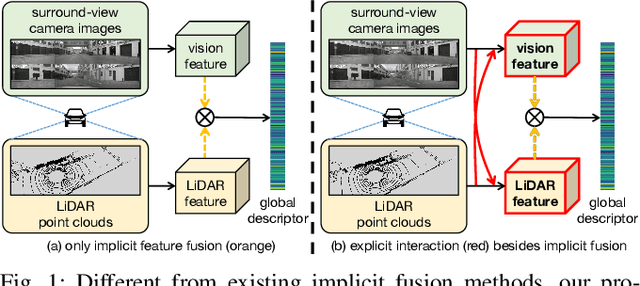
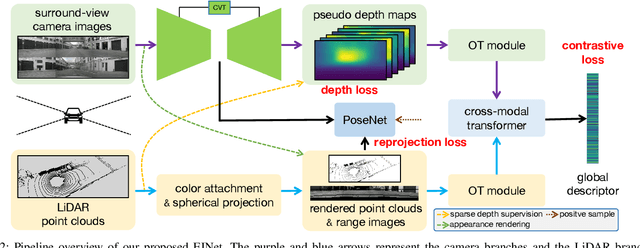
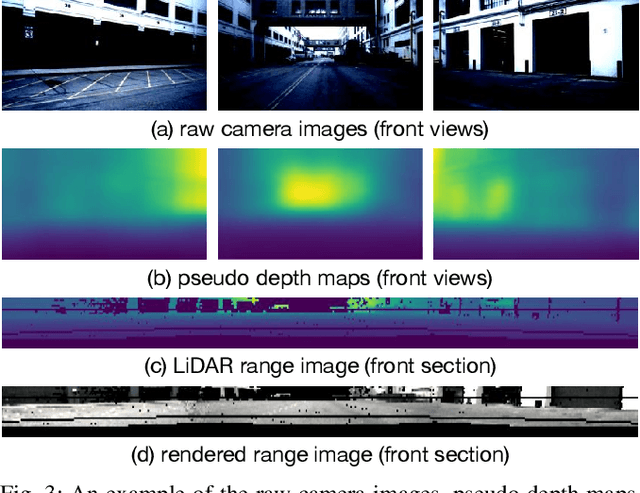
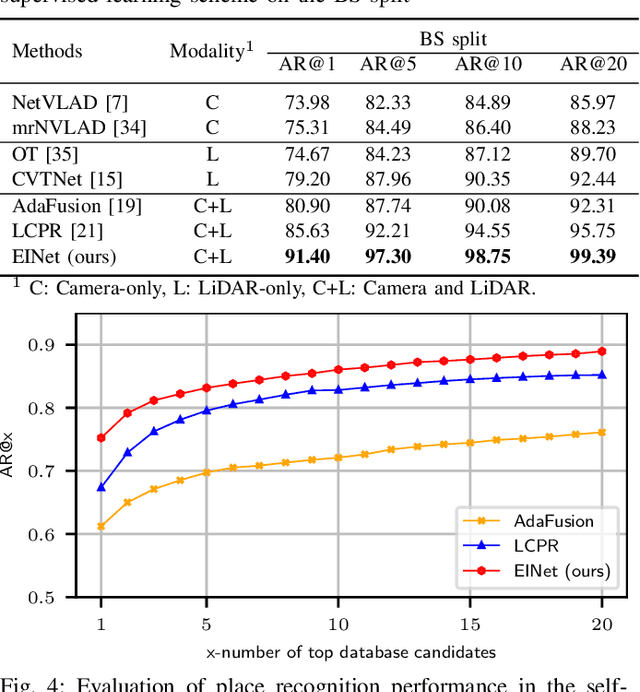
Abstract:Fusion-based place recognition is an emerging technique jointly utilizing multi-modal perception data, to recognize previously visited places in GPS-denied scenarios for robots and autonomous vehicles. Recent fusion-based place recognition methods combine multi-modal features in implicit manners. While achieving remarkable results, they do not explicitly consider what the individual modality affords in the fusion system. Therefore, the benefit of multi-modal feature fusion may not be fully explored. In this paper, we propose a novel fusion-based network, dubbed EINet, to achieve explicit interaction of the two modalities. EINet uses LiDAR ranges to supervise more robust vision features for long time spans, and simultaneously uses camera RGB data to improve the discrimination of LiDAR point clouds. In addition, we develop a new benchmark for the place recognition task based on the nuScenes dataset. To establish this benchmark for future research with comprehensive comparisons, we introduce both supervised and self-supervised training schemes alongside evaluation protocols. We conduct extensive experiments on the proposed benchmark, and the experimental results show that our EINet exhibits better recognition performance as well as solid generalization ability compared to the state-of-the-art fusion-based place recognition approaches. Our open-source code and benchmark are released at: https://github.com/BIT-XJY/EINet.
LCPR: A Multi-Scale Attention-Based LiDAR-Camera Fusion Network for Place Recognition
Nov 06, 2023Abstract:Place recognition is one of the most crucial modules for autonomous vehicles to identify places that were previously visited in GPS-invalid environments. Sensor fusion is considered an effective method to overcome the weaknesses of individual sensors. In recent years, multimodal place recognition fusing information from multiple sensors has gathered increasing attention. However, most existing multimodal place recognition methods only use limited field-of-view camera images, which leads to an imbalance between features from different modalities and limits the effectiveness of sensor fusion. In this paper, we present a novel neural network named LCPR for robust multimodal place recognition, which fuses LiDAR point clouds with multi-view RGB images to generate discriminative and yaw-rotation invariant representations of the environment. A multi-scale attention-based fusion module is proposed to fully exploit the panoramic views from different modalities of the environment and their correlations. We evaluate our method on the nuScenes dataset, and the experimental results show that our method can effectively utilize multi-view camera and LiDAR data to improve the place recognition performance while maintaining strong robustness to viewpoint changes. Our open-source code and pre-trained models are available at https://github.com/ZhouZijie77/LCPR .
Online Resource Allocation with Convex-set Machine-Learned Advice
Jun 21, 2023Abstract:Decision-makers often have access to a machine-learned prediction about demand, referred to as advice, which can potentially be utilized in online decision-making processes for resource allocation. However, exploiting such advice poses challenges due to its potential inaccuracy. To address this issue, we propose a framework that enhances online resource allocation decisions with potentially unreliable machine-learned (ML) advice. We assume here that this advice is represented by a general convex uncertainty set for the demand vector. We introduce a parameterized class of Pareto optimal online resource allocation algorithms that strike a balance between consistent and robust ratios. The consistent ratio measures the algorithm's performance (compared to the optimal hindsight solution) when the ML advice is accurate, while the robust ratio captures performance under an adversarial demand process when the advice is inaccurate. Specifically, in a C-Pareto optimal setting, we maximize the robust ratio while ensuring that the consistent ratio is at least C. Our proposed C-Pareto optimal algorithm is an adaptive protection level algorithm, which extends the classical fixed protection level algorithm introduced in Littlewood (2005) and Ball and Queyranne (2009). Solving a complex non-convex continuous optimization problem characterizes the adaptive protection level algorithm. To complement our algorithms, we present a simple method for computing the maximum achievable consistent ratio, which serves as an estimate for the maximum value of the ML advice. Additionally, we present numerical studies to evaluate the performance of our algorithm in comparison to benchmark algorithms. The results demonstrate that by adjusting the parameter C, our algorithms effectively strike a balance between worst-case and average performance, outperforming the benchmark algorithms.
PCPNet: An Efficient and Semantic-Enhanced Transformer Network for Point Cloud Prediction
Apr 16, 2023Abstract:The ability to predict future structure features of environments based on past perception information is extremely needed by autonomous vehicles, which helps to make the following decision-making and path planning more reasonable. Recently, point cloud prediction (PCP) is utilized to predict and describe future environmental structures by the point cloud form. In this letter, we propose a novel efficient Transformer-based network to predict the future LiDAR point clouds exploiting the past point cloud sequences. We also design a semantic auxiliary training strategy to make the predicted LiDAR point cloud sequence semantically similar to the ground truth and thus improves the significance of the deployment for more tasks in real-vehicle applications. Our approach is completely self-supervised, which means it does not require any manual labeling and has a solid generalization ability toward different environments. The experimental results show that our method outperforms the state-of-the-art PCP methods on the prediction results and semantic similarity, and has a good real-time performance. Our open-source code and pre-trained models are available at https://github.com/Blurryface0814/PCPNet.
Online Learning and Matching for Resource Allocation Problems
Nov 18, 2019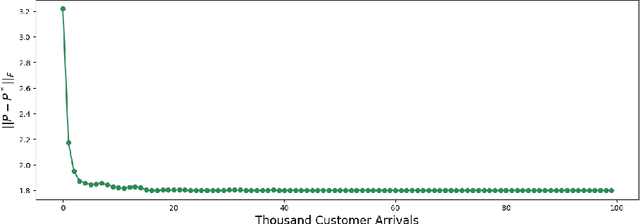
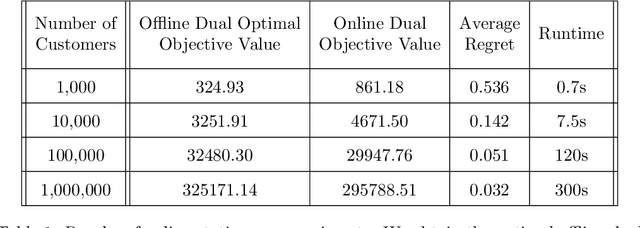
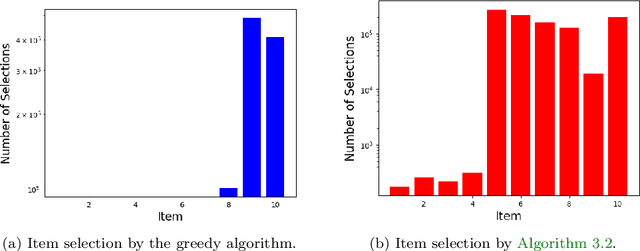
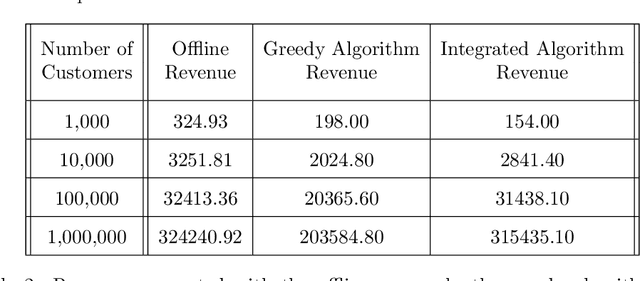
Abstract:In order for an e-commerce platform to maximize its revenue, it must recommend customers items they are most likely to purchase. However, the company often has business constraints on these items, such as the number of each item in stock. In this work, our goal is to recommend items to users as they arrive on a webpage sequentially, in an online manner, in order to maximize reward for a company, but also satisfy budget constraints. We first approach the simpler online problem in which the customers arrive as a stationary Poisson process, and present an integrated algorithm that performs online optimization and online learning together. We then make the model more complicated but more realistic, treating the arrival processes as non-stationary Poisson processes. To deal with heterogeneous customer arrivals, we propose a time segmentation algorithm that converts a non-stationary problem into a series of stationary problems. Experiments conducted on large-scale synthetic data demonstrate the effectiveness and efficiency of our proposed approaches on solving constrained resource allocation problems.
 Add to Chrome
Add to Chrome Add to Firefox
Add to Firefox Add to Edge
Add to Edge